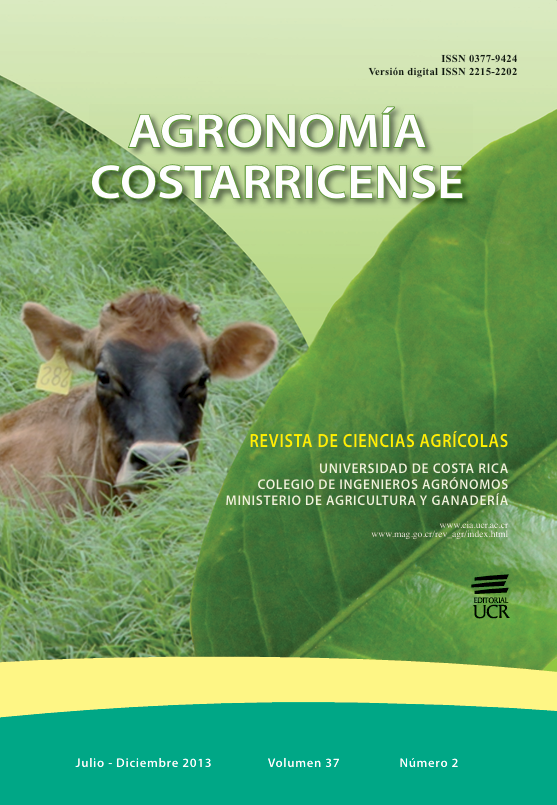Abstract
The purpose of this study was to evaluate the effect of increasing density of Meloidogyne exigua on the development of nursery plants. Coffee plantlets of the Caturra variety were transplanted into polyethylene bags with 1335 cm3 of disinfected substrate, to establish a trial with a randomized complete block design, with 8 replicates. The treatments applied included initial populations (Pi) of 0; 0,125; 0,25; 0,5; 1; 2; 4; 8; 16; 32 and 64 eggs + J2/cm3 substrate applied one month after transplant. The model y=m+(1-m) ZP-T applied 234 days after transplant to the height, diameter, number of nodes and aerial fresh weight, indicated that the tolerance limit (T) was 0,66; 0,06; 0,13 and 0,88 eggs + J2/cm3, respectively; the relative minimum production (m) was 0,79; 0,79; 0,33 and 0,54 respectively, at Pi equal to or higher than 64 eggs + J2/cm3. The gall index reached its maximum from a Pi of 2; the maximum peak of nematodes on the soil and roots was reached with a Pi between 2 and 4 while, the maximum rate of reproduction rate was 114 with a Pi of 0,125. It was concluded that the critical density was close to zero eggs/cm3 of substrate as initial population, and the nursery plants should develop free of nematodes since, even with a low Pi; it could reach the maximum population in a short time.
References
ALPIZAR E. 2003. Evaluación de la patogenicidad de poblaciones de Meloidogyne exigua en genotipos de Coffea arabica con diferentes niveles de resistencia. Tesis de maestría, Universidad de Costa Rica, San José, Costa Rica. 39 p.
ALVARADO M., LÓPEZ R. 1981. Extracción de nematodos fitoparásitos asociados al arroz, cv. CR.1113, mediante modificaciones de las técnicas de centrifugación, flotación y embudo de Baermann modificado. Agronomía Costarricense 5(1/2):7-13.
DI VITO M., CROZZOLI R., VOVLAS N. 2000. Pathogenicity of Meloidogyne exigua on coffee (Coffea arabica L.) in pots. Nematropica 30(1):55-61.
FERREIRA I., CROZZOLI R. 1995. Efectos del nematodo agallador Meloidogyne exigua sobre el crecimiento de plantas de café en vivero. Nematol. medit. 23:325-328.
FIGUEROA A. 1974. Nemátodos en café. Boletín Técnico (Costa Rica) Nº. 62.
FIGUEROA A. 1988. Análisis del problema de los nemátodos en viveros de café (Coffea arabica L.). MIP Nº. 8:12-21.
FRANKLIN M.T. 1962. Preparation of posterior cuticular patterns of Meloidogyne spp., for identification. Nematologica 7:336-337.
GONÇALVES W. 1992. Melhoramento do cafeeiro visando resistência a nematóides. Informe Agropecuário (Brasil) 16(172):66-72.
HERNÁNDEZ A. 2007. Caracterización de la diversidad de nemátodos agalladores (Meloidogy-ne sp.) asociados al cultivo del cafeto de Centroamérica. Boletín IICAPROMECAFE Nº. 112. Julio-septiembre 2007. 8-11.
ICAFE. 1998. Manual de recomendaciones para el cultivo del café. Centro de Investigaciones en Café, Heredia, Costa Rica. 193 p.
LÓPEZ R., SALAZAR L. 1989. Meloidogyne arabicida sp., n. (Nemata: Heteroderidae) nativo de Costa Rica: un nuevo y severo patógeno del cafeto. Turrialba 39(3):313-323.
ROJAS M. 2008. Avance sobre la caracterización morfológica y molecular de especies de Meloido-gyne en cafetales de Costa Rica. Simposio Nacional de Caficultura, Instituto del Café de Costa Rica. Heredia, Costa Rica. 11 p.
SALAS L., ECHANDI E. 1961. Nemátodos parásitos en plantaciones de café de Costa Rica. Café (Costa Rica) 3(8):21-24.
SEINHORST J. 1965. The relation between nematode density and damage to plants. Nematologica 11:137-154.
VILLAIN L., ANZUETO F., HERNÁNDEZ A., SARAH J. 1999. Los nemátodos parásitos del cafeto, pp. 327-367. In: B. Bertrand y B. Rapidel (eds.). Desafíos de la caficultura en Cen-troamérica. IICA/PROMECAFE, CIRAD, IRD, CCCR.
VILLAIN L., SARAH J., HERNÁNDEZ A., CHARMETANT P., BERTRAND B., ANTHONY F., TOPART P., LASHERMES P., ANZUETO F., CARNEIRO R. 2006. Biodiversity of root knot nematodes, on coffee in Cen-tral America. ASIC, París, Francia. Consultada el 19 de marzo de 2012 en http://asic-cafe.org/en/system/files/PA189_2006.pdf
VOVLAS N., DI VITO M. 1991. Effect of root-knot nematodes Meloidogyne incognita and M. javanica on the growth of coffee (Coffea arabica L.) in pots. Nematol. Medit. 19:253-258.
##plugins.facebook.comentarios##

This work is licensed under a Creative Commons Attribution-NonCommercial-NoDerivatives 4.0 International License.
Copyright (c) 2016 Agronomía Costarricense


